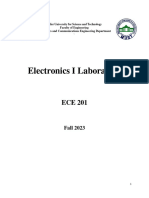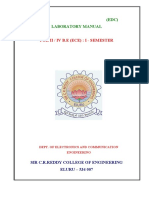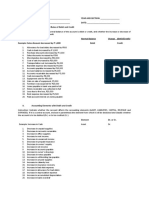Lab Report 2
Uploaded by
Yohannes AlemayehuLab Report 2
Uploaded by
Yohannes AlemayehuAddis
Ababa University
Faculty of Technology
Department of Electrical and Computer Engineering
Laboratory Report
Course number: Eceg:‐ 2205 ‐ Electrical Engineering Laboratory II
Experiment Number: 02
Title: Semiconductor Diode Characteristics
Figure A: Circuit symbol for a semiconductor diode
By: Besufekad Mekuria
Group: 1B, Subgroup 5, ID: TCR/0590/01
Date of Lab. session: November 04, 2009
Date of submission: November 11, 2009
AAU, FACULTY OF TECHNOLOGY, DEPARTMENT OF ELECTRICAL ENGINEERING, LABORATORY REPORT 0
TABLE OF CONTENTS:
Section SubTitle Location
NO
1.1 Introduction Page Two
1.2 Objective Page Two
1.3 Preparation Page Two
1.4 Used Equipment Page Two
1.5 Components used Page Three
1.6 Theory Page Three
1.7 Procedure Page Four
1.8 Calculations Page Four
1.9 Results Page Five
1.10 Conclusion Page Six
AAU, FACULTY OF TECHNOLOGY, DEPARTMENT OF ELECTRICAL ENGINEERING, LABORATORY REPORT 1
SEMICONDUCTOR DIODE CHARACTERISTICS
1.1 INTRODUCTION
Semiconductor junction diodes are a special kind of two‐terminal circuit elements constructed
by attaching a P‐type semiconductor with an N‐type semiconductor.
Junction‐type diodes consist of a junction of two different kinds of semiconductor material. For
instance, the Zener diode is a special junction‐type diode, using silicon, in which the voltage across the
junction is independent of the current through the junction. Because of this characteristic, Zener diodes
are used as voltage regulators. Another special junction‐type diode is used in solar cells; a voltage
appears spontaneously when the junction is illuminated. In light‐emitting diodes (LEDs), on the other
hand, a voltage applied to the semiconductor junction results in the emission of light energy. LEDs are
used in numerical displays such as those on electronic digital watches and pocket calculators.
1.2 OBJECTIVE
A. To introduce diodes in the networks. And to develop the skill of using them in voltage and
current manipulation.
B. To observe the voltage – current characteristics of circuits containing diodes.
C. To check whether or not the “Boltzmann’s diode equation” holds true in the practical world.
D. To observe the special voltages in the voltage – current relationship such as the cut‐in voltages
and the breakdown voltages
1.3 PRE‐LAB PREPARATION
While performing on the laboratory session, a laboratory manual was supplied by the instructors.
This manual included all the necessary information that was important in predetermining the current
and voltage relationships we also obtained in the class room notes, these formulas will be discussed in
Section 1.5 and 1.6 (the Theory and Procedure sections) of this booklet.
1.4 USED EQUIPMENT
No Description Code/Lab Reference Quantity
1 Cathode Ray oscilloscope ‐ 1
2 Vaccum Tube Voltmeter ‐ 1
3 Direct Current Ammeter ‐ 1
Table 1: Electrical Equipments that were used to set up the circuit for the laboratory procedure
AAU, FACULTY OF TECHNOLOGY, DEPARTMENT OF ELECTRICAL ENGINEERING, LABORATORY REPORT 2
1.5 USED COMPONENTS
No Description Type Quantity
1 Resistor 180 Ω 1
2 Resistor 39 Ω 1
3 Resistor 4.7 Ω 1
4 Zener Diode ‐ 1
5 Rectifying Diode IN 4001 2
Table 2: Electrical Components that were used to set up the circuit for the laboratory procedure
1.6 THEORY
B 4.7 Ω
D1
C
39 Ω F
D2
Es 180 Ω 10 Ω
Figure 1: Procedural diagram for the laboratory session
The operating principles of diodes resides in the electrical properties of extrinsic semiconductors which are
tetravalent element such as silicon doped with or mixed with either a trivalent element such as boron or a
pentavalent element such as arsenic.
In theory, the special current – Voltage relationships can be used to regulate the output of the circuit.
Especially the cut in voltages for the forward biased condition and the breakdown voltages for the reverse biased
condition.
If an external potential of V volts is applied across the p‐n junction such that the positive terminal is
connected to the n‐type material and the negative terminal is connected to the p‐type material, the number of
uncovered positive ions in the depletion region of the n‐type material will increase due to the large number of
“free” electrons drawn to the positive potential of the applied voltage. For similar reasons, the number of
uncovered negative ions will increase in the p‐type material.
A semiconductor diode is forward‐biased when the association p‐type and positive
and n‐type and negative has been established. The application of a forward‐bias potential VD will “pressure”
electrons in the n‐type material and holes in the p‐type material to recombine with the ions near the boundary and
reduce the width of the depletion region.
AAU, FACULTY OF TECHNOLOGY, DEPARTMENT OF ELECTRICAL ENGINEERING, LABORATORY REPORT 3
1.7 PROCEDURE
1. The network for the procedure was set up according to ‘Figure 1’.
2. The oscilloscope was set up in such a way that point F was connected to the vertical scope, and
the point E to the horizontal scope.
3. The Leybold AC source was supplied to the circuit.
4. Then, the volts/division of the horizontal and the vertical scope were manipulated in the
following manner.
¾ H : 1V/Div V : 20mV/Div
¾ H : 0. 1V/Div V : 20mV/Div
¾ H : 1V/Div V : 20mV/Div, and Leybold source set to 6Vrms and display was connected to 10Ω
5. And lastly, the vertical scope of the oscilloscope was connected in parallel to the zener diode,
hereby displaying its properties and they were recorded.
6. Then, the voltage variation was recorded at specified currents of: 1.0, 1.6, 0.25, 0.40, 0.60, and
0.80(A), while making sure that the top limit current of 1A was not surpassed.
1.8 Calculations
All of the necessary calculations required can be summarized as follows:
I = Is(ekv/tk-1)
And note that: static resistance = V/I
Static resistance (Rs) = 0.2/2mA
= 0.1K or 100 Ω
Dynamic Resistance = ∆V/∆I
= 4-2/20mA-10mA
= 2V/10mA = 0.2K Ω or 200 Ω
AAU, FACULTY OF TECHNOLOGY, DEPARTMENT OF ELECTRICAL ENGINEERING, LABORATORY REPORT 4
1.9 Results
After completing setting up the circuit, the voltage measurements at the points specified on the
procedure were measured, here is the values obtained by measuring the voltage while varying the
current.
Tabulation for Procedure A3,
Current (mA) 1.0 1.6 2.5 4.0 6.0 10 16 25 40 60 80 100 250 400 600
Voltage (V) 0.45 0.5 0.52 0.55 0.57 0.59 0.61 0.62 0.64 0.65 0.66 0.68 0.70 0.72 0.75
Tabulation for Procedure A4,
Voltage Current
2V 0µA
4V 0µA
6V 0µA
10V 0µA
Oscilloscope voltage Displays for variable volage per divisions:
1. For x: 1v/Div, Y:20mV/Div 2. For x: 0.1v/Div, Y:20mV/Div
3. For x:0. 1v/Div, Y:20mV/Div 4. For x: 1v/Div, Y:20mV/Div.
AAU, FACULTY OF TECHNOLOGY, DEPARTMENT OF ELECTRICAL ENGINEERING, LABORATORY REPORT 5
1.10 Conclusion
Upon completion of the laboratory session, many observations were made; these observations have been
dealt with here under their own subheading.
Observations made from Analysis of the voltage – current relationships.
¾ For the Forward biased condition, the voltage and current do indeed relate exponentially to one other
once the “cut‐in” voltage has been passed.
¾ And in the reverse biased condition, the current flow will be greatly limited once the stage of
“Breakdown” is surpassed. This is represented by an almost straight vertical line in the current‐voltage
graph in the breakdown region.
¾ This current relation can be represented by the following formula:
I = Is(ekv/tk-1)
¾ Changing the voltage per division values of the Cathode Ray Oscilloscope doesn’t affect the breakdown
or the cut in voltage values, but a change in the appearance of the graph displayed on the oscilloscope
may change also the slopes of the lines may change, but quantitatively speaking, all of the graphs
represent the exact same phenomenon.
Observations made about practical errors
It is a well known fact that there does not exist a circuit element that functions with a hundred percent
efficiency. Therefore slight deviations of the measured values from the calculated ones are to be expected under
any circumstances. However the possible causes for these irregularities include:
• The DC voltmeter does not give rise to a potential difference with a magnitude that it is programmed to do.
This is generally due to manufacturing defects, defects from improper usage and gradual wearing off.
• The leads are not of Zero Resistance; this is because of factors like: Temperature change, corrosion, etc…
• The Ammeter used was an analog device; therefore readings are perceptible to be misconstrued. And also
continuous mistreatment of the device leads to incorrect readings in the future.
End of Report
AAU, FACULTY OF TECHNOLOGY, DEPARTMENT OF ELECTRICAL ENGINEERING, LABORATORY REPORT 6
You might also like
- Thinking in Systems and Mental - Marcus P. Dawson100% (1)Thinking in Systems and Mental - Marcus P. Dawson306 pages
- Electronic Devices and Circuits Lab NewNo ratings yetElectronic Devices and Circuits Lab New86 pages
- Coding Club Level 3 Python Building Big Apps PDF100% (1)Coding Club Level 3 Python Building Big Apps PDF134 pages
- Lab Manual: EGCI 232 Engineering ElectronicsNo ratings yetLab Manual: EGCI 232 Engineering Electronics26 pages
- Electronic Devices Circuits (Edc) Laboratory Manual: For Ii / Iv B.E (Ece) : I - SemesterNo ratings yetElectronic Devices Circuits (Edc) Laboratory Manual: For Ii / Iv B.E (Ece) : I - Semester80 pages
- EE-252-Electronic Devices & Digital Electronics Laboratory Manual/ RecordNo ratings yetEE-252-Electronic Devices & Digital Electronics Laboratory Manual/ Record85 pages
- Basic Electrical - Electronics Lab Manual PDFNo ratings yetBasic Electrical - Electronics Lab Manual PDF48 pages
- Electronics-I: Name: - Reg. No: - Section: - Group100% (1)Electronics-I: Name: - Reg. No: - Section: - Group55 pages
- Electronics I (EECE 3110) Lab 5: MosfetsNo ratings yetElectronics I (EECE 3110) Lab 5: Mosfets9 pages
- Title: Testing of A Rectifier Circuit: EEE1003 Electrical WorkshopNo ratings yetTitle: Testing of A Rectifier Circuit: EEE1003 Electrical Workshop5 pages
- Electronic Devices and Circuits Lab Manual PDFNo ratings yetElectronic Devices and Circuits Lab Manual PDF33 pages
- Electromagnetic Compatibility (EMC) Design and Test Case AnalysisFrom EverandElectromagnetic Compatibility (EMC) Design and Test Case AnalysisNo ratings yet
- Design of Electrical Circuits using Engineering Software ToolsFrom EverandDesign of Electrical Circuits using Engineering Software ToolsNo ratings yet
- Grinblat 2021 Nonlinear Dielectric Nanoantennas and Metasurfaces Frequency Conversion and Wavefront ControlNo ratings yetGrinblat 2021 Nonlinear Dielectric Nanoantennas and Metasurfaces Frequency Conversion and Wavefront Control27 pages
- Advanced Science - 2022 - Reineke Matsudo - Efficient Frequency Conversion With Geometric Phase Control in OpticalNo ratings yetAdvanced Science - 2022 - Reineke Matsudo - Efficient Frequency Conversion With Geometric Phase Control in Optical12 pages
- Promotional Strategies & Print Ad For Cold Creams100% (1)Promotional Strategies & Print Ad For Cold Creams12 pages
- Map Server For Visualizing Air Traffic Based On Data From A Remote Pseudo RadarNo ratings yetMap Server For Visualizing Air Traffic Based On Data From A Remote Pseudo Radar14 pages
- Autodesk Navisworks 2014 Service Pack 1 Features Readme PDFNo ratings yetAutodesk Navisworks 2014 Service Pack 1 Features Readme PDF6 pages
- BADENAS y AURELL, 2004 - Sea Level Changes, JabaloyasNo ratings yetBADENAS y AURELL, 2004 - Sea Level Changes, Jabaloyas17 pages
- A New Radar Waveform Design Algorithm With Improved Feasibility For Spectral CoexistenceNo ratings yetA New Radar Waveform Design Algorithm With Improved Feasibility For Spectral Coexistence10 pages
- PM Reyes Notes On Taxation 2 - Valued Added Tax (Working Draft)100% (1)PM Reyes Notes On Taxation 2 - Valued Added Tax (Working Draft)22 pages
- 24by09in00002376 - Sky Ventureszdup - 27-07-2024No ratings yet24by09in00002376 - Sky Ventureszdup - 27-07-20242 pages
- Federal Investigation Agency (FIA) : Recruitment TestNo ratings yetFederal Investigation Agency (FIA) : Recruitment Test4 pages
- Differential geometry of manifolds Second Edition Lovett 2024 scribd downloadNo ratings yetDifferential geometry of manifolds Second Edition Lovett 2024 scribd download55 pages
- A Guide to Electronic Maintenance and RepairsFrom EverandA Guide to Electronic Maintenance and Repairs
- Electronic Devices Circuits (Edc) Laboratory Manual: For Ii / Iv B.E (Ece) : I - SemesterElectronic Devices Circuits (Edc) Laboratory Manual: For Ii / Iv B.E (Ece) : I - Semester
- EE-252-Electronic Devices & Digital Electronics Laboratory Manual/ RecordEE-252-Electronic Devices & Digital Electronics Laboratory Manual/ Record
- Electronics-I: Name: - Reg. No: - Section: - GroupElectronics-I: Name: - Reg. No: - Section: - Group
- Title: Testing of A Rectifier Circuit: EEE1003 Electrical WorkshopTitle: Testing of A Rectifier Circuit: EEE1003 Electrical Workshop
- Electromagnetic Compatibility (EMC) Design and Test Case AnalysisFrom EverandElectromagnetic Compatibility (EMC) Design and Test Case Analysis
- Design of Electrical Circuits using Engineering Software ToolsFrom EverandDesign of Electrical Circuits using Engineering Software Tools
- Grinblat 2021 Nonlinear Dielectric Nanoantennas and Metasurfaces Frequency Conversion and Wavefront ControlGrinblat 2021 Nonlinear Dielectric Nanoantennas and Metasurfaces Frequency Conversion and Wavefront Control
- Advanced Science - 2022 - Reineke Matsudo - Efficient Frequency Conversion With Geometric Phase Control in OpticalAdvanced Science - 2022 - Reineke Matsudo - Efficient Frequency Conversion With Geometric Phase Control in Optical
- Map Server For Visualizing Air Traffic Based On Data From A Remote Pseudo RadarMap Server For Visualizing Air Traffic Based On Data From A Remote Pseudo Radar
- Autodesk Navisworks 2014 Service Pack 1 Features Readme PDFAutodesk Navisworks 2014 Service Pack 1 Features Readme PDF
- BADENAS y AURELL, 2004 - Sea Level Changes, JabaloyasBADENAS y AURELL, 2004 - Sea Level Changes, Jabaloyas
- A New Radar Waveform Design Algorithm With Improved Feasibility For Spectral CoexistenceA New Radar Waveform Design Algorithm With Improved Feasibility For Spectral Coexistence
- PM Reyes Notes On Taxation 2 - Valued Added Tax (Working Draft)PM Reyes Notes On Taxation 2 - Valued Added Tax (Working Draft)
- Federal Investigation Agency (FIA) : Recruitment TestFederal Investigation Agency (FIA) : Recruitment Test
- Differential geometry of manifolds Second Edition Lovett 2024 scribd downloadDifferential geometry of manifolds Second Edition Lovett 2024 scribd download































































































